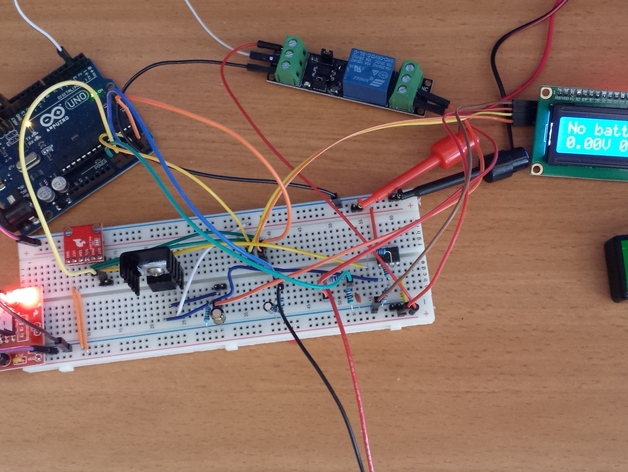
Intelligent charger for 9V NiMH rechargeable batteries V1
thingiverse
I was looking for a smart charger that could charge a 9V NiMH battery in just a couple of hours, but I couldn't find one. So, I decided to build my own. This project involves creating a custom charging circuit using an Arduino board and various components like resistors, capacitors, and a digital-to-analog converter (DAC). The charger will monitor the battery's voltage and current levels in real-time and adjust its output accordingly to ensure safe and efficient charging. The first step is to create a charging circuit. I used a SparkFun I2C DAC Breakout - MCP4725, which is a 12-bit digital-to-analog converter that can control the output voltage between 0 and 5V. However, because we need to be able to adjust the voltage in a wider range, from 0 to 15V, an operational amplifier (LM358) was used to amplify the output voltage of the DAC. The amplification is set by resistors R4 and R3, with a gain of approximately 3.06. Next, I connected the output of the operational amplifier to the ADJ terminal of an LM317 adjustable voltage regulator. This regulator will maintain 1.2V between its ADJ and OUT terminals, allowing us to configure the actual voltage on the battery between 1.2 and 16.2V. To ensure regulation if the battery is not connected, a 1kOhm resistor (R6) was used. I measured the voltage at two different points: the charging circuit output and the battery itself. The voltage on the charging circuit output can be up to 16.2V, so a resistive divider (R1,R2) was used to bring the voltage below 5V, which is allowed by the Arduino board. To disconnect the battery from the charging circuit when charging is complete, a relay was used. Any relay with a 5V control can be used, but it's more safe to connect the battery to normally open contacts of the relay. I also used an I2C SERIAL LCD 1602 MODULE (YwRobot) to display the status of the charger, but any other I2C controlled LCD module can be used. If you're using a different LCD module, you'll need to change the LiquidCrystal library. To power the digital-to-analog converter and the LCD, I used a SparkFun Breadboard Power Supply 5V/3.3V. It's probably okay to use 5V from the Arduino board as well. Finally, you will also need to supply 17V to the charging circuit. If you don't have a power supply, you can use an adjustable DC/DC converter like this. The functionality of the charger is simple: it charges the battery with a constant current until fully charged and then switches to trickle charging for a maximum of 10 hours. The charging parameters are configured in the code: float target_current_mA=30; // Charging current mA float battery_nominal_capacity_mA=170; // Nominal capacity of battery mA float max_time_for_trickle_charge=6; // Maximum trickle charge time in minutes After power is up, the charger checks if a battery is connected. If it is, the battery will be charged with the configured constant current until fully charged. Charging is terminated by detecting negative dV/dt during 5 minutes. After charging is complete, the charger switches to trickle charging with a current of C/40. The charger disconnects itself from the battery after the maximum trickle charge time has elapsed. I hope this helps you build your own smart charger for NiMH batteries!
With this file you will be able to print Intelligent charger for 9V NiMH rechargeable batteries V1 with your 3D printer. Click on the button and save the file on your computer to work, edit or customize your design. You can also find more 3D designs for printers on Intelligent charger for 9V NiMH rechargeable batteries V1.
